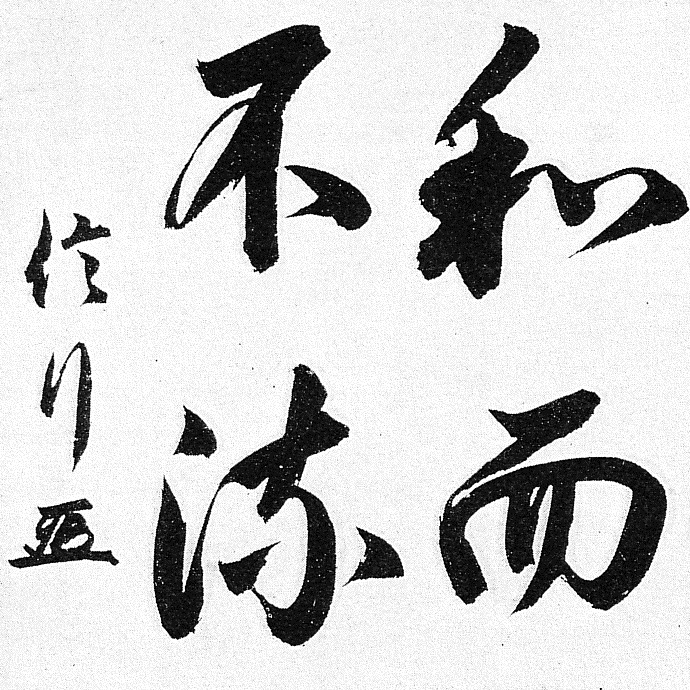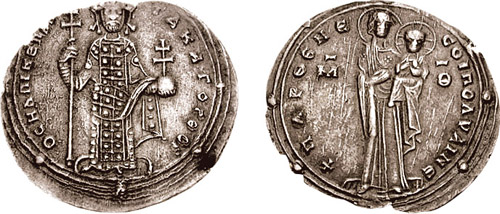|
Fujiwara Kozei
was a Japanese calligrapher (''shodoka'') during the Heian period. He was memorialized for his prowess in his chosen art by being remembered as one of the outstanding Three Brush Traces ( Sanseki 三跡), along with Ono no Michikaze and Fujiwara no Sukemasa. Life Yukinari was the son of a courtier by the name of Fujiwara no Yoshitaka. After the early death of his father, he was raised by his grandfather, Prince Kanenori. Yukinari had a fairly successful career as a court official, where he served as a Major Counselor. Yukinari further improved the Japanese style calligraphy (''wayō-shodō'' 和様書道), and showed great respect to its founder, Ono no Michikaze (894-966). He even mentioned in his diary, ''Gonki'', that he had a dream wherein he met Michikaze and learnt calligraphy from him. Yukinari was known as the master of kana. His style was mild and easily emulated, his lines were dainty and exquisite, resulting in highly elegant characters. Fujiwara Yukinari is ... [...More Info...] [...Related Items...] OR: [Wikipedia] [Google] [Baidu] |
Kikuchi Yōsai
, also known as Kikuchi Takeyasu and Kawahara Ryōhei, was a Japanese people, Japanese painter most famous for his monochrome portraits of historical figures. Biography The son of a samurai named Kawahara of Edo, he was adopted by a family named Kikuchi (surname), Kikuchi. When eighteen, he became a pupil of Takata Enjō; but, after studying the principles of the Kanō school, Kanō, Shijō school, Shijō, and Maruyama schools, perhaps, under Ozui, a son of Maruyama Ōkyo, Ōkyo, he developed an independent style, having some affinities with that of Tani Bunchō. His illustrated history of Japanese heroes, the ''Zenken Kojitsu'', is a remarkable specimen of his skill as a draughtsman in monochrome ink. In order to produce this work, and his many other portraits of historical figures, he performed extensive historical, and even archaeological, research. ''Zenken Kojitsu'' features over 500 major figures in Japanese history, and was originally printed as a series of ten woodbl ... [...More Info...] [...Related Items...] OR: [Wikipedia] [Google] [Baidu] |
Gyōsho
Semi-cursive script, also known as running script, is a style of Chinese calligraphy that emerged during the Han dynasty (202 BC220 AD). The style is used to write Chinese characters and is abbreviated slightly where a character's strokes are permitted to be visibly connected as the writer writes, but not to the extent of the cursive style. This makes the style easily readable by readers who can read regular script and quickly writable by calligraphers who require ideas to be written down quickly. In order to produce legible work using the semi-cursive style, a series of writing conventions is followed, including the linking of the strokes, simplification and merging strokes, adjustments to stroke order and the distribution of text of the work. One of the most notable calligraphers who used this style was Wang Xizhi (303–361). Wang is known for the ''Lantingji Xu'' ('Preface to the Orchid Pavilion Collection'), a work published in 353 which remains highly influential ... [...More Info...] [...Related Items...] OR: [Wikipedia] [Google] [Baidu] |
1028 Deaths
Year 1028 ( MXXVIII) was a leap year starting on Monday of the Julian calendar. Events By place Byzantine Empire * November 11 – Emperor Constantine VIII dies at Constantinople after a 3-year reign.Ladner, Gerhart B. Images and Ideas in the Middle Ages: Selected Studies in History and Art, Volume 1'. Ed. di Storia e Letteratura, 1983. 315. On his deathbed, and without a male heir, Constantine arranges that his eldest daughter, Zoë Porphyrogenita, succeeds him and marries the Byzantine nobleman, Romanos III (Argyros). * November 15 – Zoë Porphyrogenita takes the throne as empress consort. Her husband, Romanos III (age 60) becomes emperor of the Byzantine Empire. England * Cnut the Great sails from England to Norway with a fleet of 50 ships. He defeats Olaf Haraldsson and is crowned king of Norway. Cnut becomes the sole ruler of England, Denmark and part of Sweden (known as the Danish North Sea Empire). Europe * April 14 – The 10-year-old Henry ... [...More Info...] [...Related Items...] OR: [Wikipedia] [Google] [Baidu] |
972 Births
Year 972 ( CMLXXII) was a leap year starting on Monday of the Julian calendar. Events By place Byzantine Empire * Spring – Emperor John I Tzimiskes divides the Bulgarian territories, recently held by the Kievan Rus', into six new themes. He turns his attention to the East against the Abbasid Caliphate and its vassals, beginning with an invasion of Upper Mesopotamia. John transfers Byzantine troops to Macedonia, and the region of Philippopolis in Thrace, to dilute the Slavs. * John I removes various Bulgarian boyars from their homes, and settles them in Constantinople and Anatolia (modern Turkey), where they are given high titles and lands. * John I grants a charter for the Monastic Republic of Holy Mount Athos, in Greece. Europe * Spring – Grand Prince Sviatoslav I is ambushed by the Pechenegs (possibly in the service of the Byzantines) and killed during his attempt to cross the Dnieper rapids (modern Ukraine). His skull is made into a drinking cup. ... [...More Info...] [...Related Items...] OR: [Wikipedia] [Google] [Baidu] |
10th-century Japanese Calligraphers
1 (one, unit, unity) is a number, numeral, and glyph. It is the first and smallest positive integer of the infinite sequence of natural numbers. This fundamental property has led to its unique uses in other fields, ranging from science to sports, where it commonly denotes the first, leading, or top thing in a group. 1 is the unit of counting or measurement, a determiner for singular nouns, and a gender-neutral pronoun. Historically, the representation of 1 evolved from ancient Sumerian and Babylonian symbols to the modern Arabic numeral. In mathematics, 1 is the multiplicative identity, meaning that any number multiplied by 1 equals the same number. 1 is by convention not considered a prime number. In digital technology, 1 represents the "on" state in binary code, the foundation of computing. Philosophically, 1 symbolizes the ultimate reality or source of existence in various traditions. In mathematics The number 1 is the first natural number after 0. Each natural number, ... [...More Info...] [...Related Items...] OR: [Wikipedia] [Google] [Baidu] |
Calligraphy
Calligraphy () is a visual art related to writing. It is the design and execution of lettering with a pen, ink brush, or other writing instruments. Contemporary calligraphic practice can be defined as "the art of giving form to signs in an expressive, harmonious, and skillful manner". In East Asia and the Islamic world, where written forms allow for greater flexibility, calligraphy is regarded as a significant art form, and the form it takes may be affected by the meaning of the text or the individual words. Modern Western calligraphy ranges from functional inscriptions and designs to fine-art pieces where the legibility of letters varies. Classical calligraphy differs from type design and non-classical hand-lettering, though a calligrapher may practice both. CD-ROM Western calligraphy continues to flourish in the forms of wedding invitations and event invitations, font design and typography, original hand-lettered logo design, religious art, announcements, graphic des ... [...More Info...] [...Related Items...] OR: [Wikipedia] [Google] [Baidu] |
Shodo
, also called , is a form of calligraphy, or artistic writing, of the Japanese language. Japanese writing system, Written Japanese was originally based on Man'yōgana, Chinese characters only, but the advent of the hiragana and katakana Japanese syllabaries resulted in intrinsically Japanese calligraphy styles. Styles The term shodō (書道, "way of writing") is of Chinese origin and is widely used to describe the art of Chinese calligraphy during the medieval Tang dynasty. Early Japanese calligraphy was originated from Chinese calligraphy. Many of its principles and techniques are very similar, and it recognizes the same basic writing styles: * seal script (篆書 ''tensho'') (pinyin: ''zhuànshū''). The seal script (tensho) was commonly used throughout the Zhou dynasty (1046–256 BC) and the following Qin dynasty (221–206 BC) of China. After this time period, tensho style fell out of popularity in favor of reisho. However, tensho was still used for titles of published ... [...More Info...] [...Related Items...] OR: [Wikipedia] [Google] [Baidu] |
Tokyo National Museum
The or TNM is an art museum in Ueno Park in the Taitō wards of Tokyo, ward of Tokyo, Japan. It is one of the four museums operated by the , is considered the oldest national museum and the largest art museum in Japan. The museum collects, preserves, and displays a comprehensive collection of artwork and cultural objects from Asia, with a focus on ancient and medieval Japanese art and Asian art along the Silk Road. There is also a large collection of Greco-Buddhist art. As of April 2023, the museum held approximately 120,000 Cultural Properties, including 89 National Treasure (Japan), National Treasures, 319 List of Hōryū-ji Treasures at Tokyo National Museum, Horyuji Treasures, and 649 Important Cultural Properties of Japan, Important Cultural Properties. As of the same date, the Japanese government had designated 902 works of art and crafts as National Treasures and 10,820 works of art and crafts as Important Cultural Properties, so the museum holds about 10% of the works of a ... [...More Info...] [...Related Items...] OR: [Wikipedia] [Google] [Baidu] |
Colophon (publishing)
In publishing, a colophon () is a brief statement containing information about the publication of a book such as an "imprint" (the place of publication, the publisher, and the date of publication). A colophon may include the device (logo) of a printer or publisher. Colophons are traditionally printed at the ends of books (see History below for the origin of the word), but sometimes the same information appears elsewhere (when it may still be referred to as colophon) and many modern (post-1800) books bear this information on the title page or on the verso of the title leaf, which is sometimes called a ''biblio page'' or (when bearing copyright data) the '' copyright page''. History The term ''colophon'' derives from the Late Latin ''colophōn'', from the Greek κολοφών (meaning "summit" or "finishing touch"). The term colophon was used in 1729 as the bibliographic explication at the end of the book by the English printer Samuel Palmer in his ''The General History of Prin ... [...More Info...] [...Related Items...] OR: [Wikipedia] [Google] [Baidu] |
Emperor Fushimi
was the 92nd emperor of Japan, according to the traditional order of succession. His reign spanned the years from 1287 through 1298. Name Before his ascension to the Chrysanthemum Throne, his personal name (his ''imina'') was . Although the Roman-alphabet spelling of the name of this 13th-century emperor is the same as the personal name of the 20th century Emperor Shōwa, the kanji are different: * Emperor Fushimi, formerly Prince Hirohito (熈仁) * Emperor Shōwa, also known as Emperor Hirohito (裕仁) Genealogy He was the second son of Emperor Go-Fukakusa. They were from the Jimyōin-tō line. *Empress: Saionji (Fujiwara) Shoshi (西園寺(藤原)鏱子) later Eifukumon’In (永福門院), Saionji Sanekane‘s daughter *Consort: Tōin (Fujiwara) Sueko (洞院(藤原)季子) later Kenshinmon-in (顕親門院; 1265-1336), Tōin Saneo‘s daughter **First daughter: Imperial Princess Jushi (甝子内親王; 1287-1310) later Sakuheimon-in (朔平門院) **Third s ... [...More Info...] [...Related Items...] OR: [Wikipedia] [Google] [Baidu] |
Ryoshi
Fujiwara no Ryoshi (藤原 旅子, also read Fujiwara no Tabiko; 759–788) was a Japanese noblewoman of the Nara period. She was a consort to Emperor Kanmu and the mother of Emperor Junna. Biography Fujiwara no Ryoshi was born in 759 to Fujiwara no Momokawa and Fujiwara no Moroe (藤原諸姉), a daughter of Fujiwara no Yoshitsugu. Like many Japanese noblewomen of the pre-modern era, the correct reading of her given name is uncertain, and the readings ''Ryoshi'' and ''Tabiko'' are speculative '' on'' and '' kun'' readings, respectively. In Enryaku, Enryaku 4 (785) she was given the Junior Third Rank. In the first month of the following year, she bore Emperor Kanmu the prince, Prince Ōtomo (大伴親王 ''Ōtomo-shinnō'', later to ascend to the throne as Emperor Junna was the 53rd emperor of Japan, Emperor Junna, Ōharano no Nishi no Minenoe Imperial Mausoleum, Imperial Household Agency according to the traditional order of succession. Junna reigned from 823 to 833. Tr ... [...More Info...] [...Related Items...] OR: [Wikipedia] [Google] [Baidu] |
Bai Juyi
Bai Juyi (also Bo Juyi or Po Chü-i; , Mandarin Chinese, Mandarin pinyin ''Bǎi Jūyì''; 772–846), courtesy name Letian (樂天), was a Chinese musician, poet, and politician during the Tang dynasty. Many of his poems concern his career or observations made about everyday life, including as governor of three different provinces. He achieved fame as a writer of verse in a low-key, near vernacular style that was popular throughout medieval East Asia. Bai was also influential in the historical development of Japanese literature, where he is better known by the on'yomi reading of his courtesy name, Haku Rakuten (shinjitai: 白楽天). His younger brother Bai Xingjian was a short story writer. Among his most famous works are the long narrative poems "Chang Hen Ge (poem), Chang Hen Ge" ("Song of Everlasting Sorrow"), which tells the story of Yang Guifei, and "Pipa xing" ("Song of the Pipa"). Life Bai Juyi lived during the Tang poetry#Middle Tang, Middle Tang period. This was a ... [...More Info...] [...Related Items...] OR: [Wikipedia] [Google] [Baidu] |






